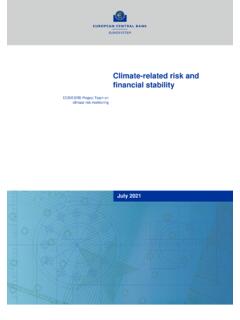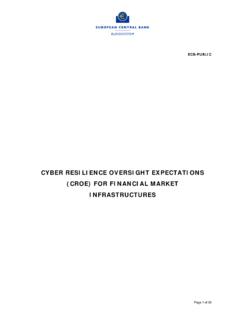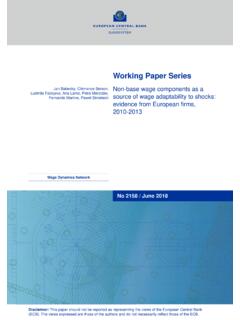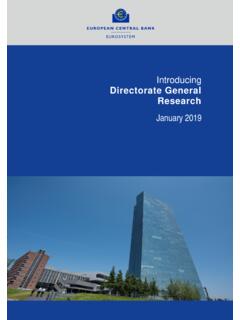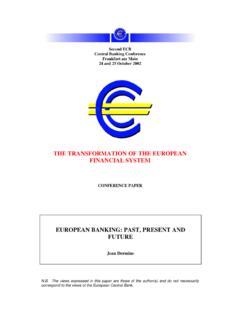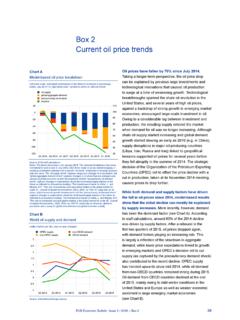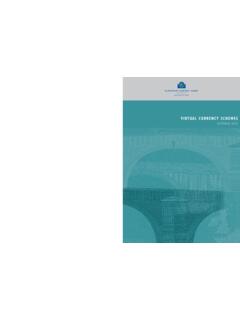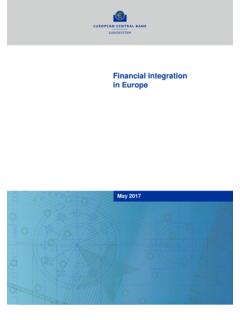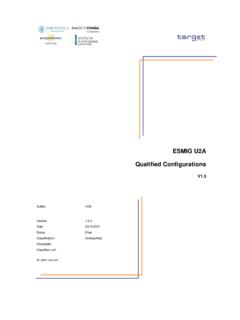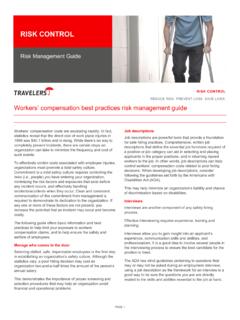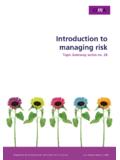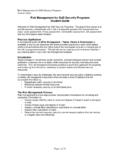Transcription of Working Paper Series - European Central Bank
1 Working Paper Series The risk management approach to monetary policy , nonlinearity and aggressiveness: the case of the US Fed Jean-Yves Gnabo and Diego Nicolas Moccero Note: This Working Paper should not be reported as representing the views of the European Central Bank (ECB). The views expressed are those of the authors and do not necessarily reflect those of the ECB No 1792 / May 2015 ECB Working Paper 1792, May 2015 1 ABSTRACT We estimate regime switching models where the strength of the response of monetary policy to macroeconomic conditions depends on the level of risk associated with the inflation outlook and risk in financial markets. Using quarterly data for the Greenspan period we find that: i) risk in the inflation outlook and volatility in financial markets are a powerful driver of monetary policy regime changes in the ; ii) the response of the US Fed to the inflation outlook is invariant across policy regimes; iii) however, in periods of high economic risk, monetary policy tends to respond more aggressively to the output gap and the degree of inertia tends to be lower than in normal circumstances; and iv) the US Fed is estimated to have responded aggressively to the output gap in the late 1980s and begging of the 1990s, and in the late 1990s and early 2000s.
2 JEL classification numbers: C24, C51, E52 Keywords: US Fed, monetary policy , risk management , smooth-transition regression model, aggressiveness. ECB Working Paper 1792, May 2015 2 NON-TECHNICAL SUMMARY Starting with Taylor (1993), a large body of literature has focused on the derivation and estimation of linear monetary policy reaction functions in the United States and abroad. Despite their simplicity, these policy rules have fit the data relatively well. More recently, economists started to focus on the possibility that monetary policy may react in a nonlinear manner to economic activity and inflation. This nonlinear behaviour may arise as a result of deviations from the conventional minimisation of quadratic loss functions subject to linear Phillips curves and aggregate demand schedules.
3 However, another factor that can lead to potential nonlinearity in monetary policy is an uncertain economic environment. Several sources of uncertainty affect the implemention of monetary policy in real time. First, policymakers are uncertain about the state of the economy because they have only an imperfect knowledge about the data used in monetary policymaking (data uncertainty). Indeed, measures of economic activity and inflation (such as real GDP and the GDP deflator) are subject to substantial revisions following the quarter of their relase; and useful concepts, such as potential output and the NAIRU are usually measured with a substantial margin of error. There seems to be agreement in the literature that policymakers should be less aggressive with respect to poorly measured targets.
4 Second, policymakers are uncertain regarding the impact of policy on the economy and about the structure of the economy (parameter uncertainty). So far, the literature has been divided as to whether or not monetary policy in the presence of parameter uncertainty should be more or less aggressive than absent uncertainty. Starting with Brainard (1967), a large body of theoretial literature postulated that uncertainty about the quantitative impact of policy on the economy should lead to less agreessiveness in monetary policy (Svensson, 1999). However, Estrella and Mishkin (1999), Peersman and Smets (1999) and Rudebusch (2001) found that parameter uncertainty has only negligible quantative effects on the feedback parameters. Yet another strand of literature shows that uncertainty regarding the structure of the economy and/or the impact of policy should lead to a more responsive approach to monetary policy (S derstr m, 2002; Giannoni, 2007; Flamini and Milas, 2011).
5 Finally, policymakers are uncertain about the distribution of shocks hitting the economy (shock uncertainty). As is well known, optimal policy in a linear-quadratic framework with only shock uncertainty exhibits certainty equivalence. Consequently, the degree of uncertainty does not affect the optimal policy rule, which depends only on the expected value of the target variables. The Central bank acts as it would in a non-stochastic economy. This is the hypothesis underlying the derivation and estimation of linear Taylor rules. This literature has been critised on the grounds that it implies that the costs of being wrong do not depend on whether the future value of inflation is over or underestimated. In the robust control approach to monetary policy , the authorities do care about the worst case scenario.
6 Indeed, they choose the policy that minimizes the loss over all possible values for a given parameter within a given range. In this case, aggressive interest rate movements might be called for in order to avoid very bad outcomes (Giannoni 2002; Onatski and Stock, 2002). The results of the robust control approach are in line with the views expressed by several US Fed Governors. Indeed, US Fed Governors have stressed on several occassions the importance of an uncertain outlook for the conduct of monetary policy ( risk management approach to monetary policy ). Former Chairman Greenspan (2004) describes this approach by stating that Given our inevitably incomplete knowledge.. a Central bank needs to consider not only the most likely future path for the economy but also the distribution of possible outcomes about that path.
7 The risk- management approach may also lead to a more aggressive response of monetary policy to macroeconomic conditions, depending on the level of risk facing the economy. Former Governor Mishkin discusses the case of financial market disruptions, which ECB Working Paper 1792, May 2015 3 pose significant risks to the macroeconomic outlook. He maintains that when financial markets are strained, risk management is crucial in formulating the appropriate response of monetary policy . In particular, he claims that policy in this setting tends to respond aggressively when a large shock becomes evident; for this reason, the degree of inertia in such cases may be markedly lower than in more routine circumstances . In that light, he maintains that the Federal Reserve s policy strategy is aimed at providing insurance to help avoid more severe macroeconomic outcomes.
8 We contribute to the empirical literature on monetary policy under uncertainty by estimating regime switching models where the strength of the response of monetary policy to macroeconomic conditions depends on the level of risk facing the economy. This monetary policy rule follows Mishkin s idea that the strength of the monetary policy response to economic shocks should depend on the variances of shocks hitting the economy. In doing so, we do not attempt to distinguish between the various theories mentioned before. Instead, we want to document empirically whether or not monetary policy implemented by the US Fed has depended on the level of risk facing the economy. Our measures of risk are based on the previoulsy mentioned statements by former Fed officials.
9 First, following Greenspan s empahsis on the distribution of outcomes around Central paths, we use measures of dispersion associated with the outlook of inflation derived from surveys among professional forecasters. Second, because former Governor Mishkin focused on the importance of stress in financial markets in formulating an appropriate monetary policy response, we use a measure of risk in financial markets derived from stock options. Moreover, we use real time data from the Greenbook to estimate the regime switching models because there is wide recognition that using ex-post data has a Series of drawbacks. The focus is on the Greenspan period because of his emphasis on the risk management approach in monetary policy making in the United States. Our starting point is the estimation of linear monetary policy feedback rules that have been widely estimated in the literature.
10 These feedback rules have been tested for neglected nonlinearity arising from the level of inflation, the output gap and the stance of monetary policy , as suggested by the empirical literature on nonlinear Taylor rules. They have also been tested for non-linearity arising from the level or risk facing the economy, as suggested by the risk management approach and the other theories mentioned before. When linearity is rejected, nonlinear Taylor rules are estimated using nonlinear least squares techniques. The main findings of the Paper are as follows: i) risk in the inflation outlook and volatility in financial markets are a more powerful driver of monetary policy regime changes than variables typically suggested in the literature, such as the level of inflation, the output gap and the Fed Funds rate; ii) estimation of regime switching models shows that the response of the US Fed to the inflation outlook is invariant across policy regimes; iii) however, in periods of high economic risk monetary policy tends to respond more aggressively to the output gap and the degree of inertia tends to be lower than in normal circumstances.
